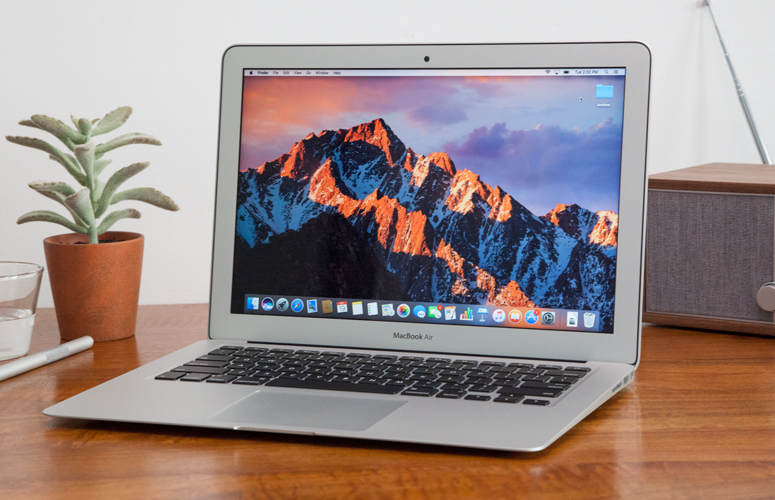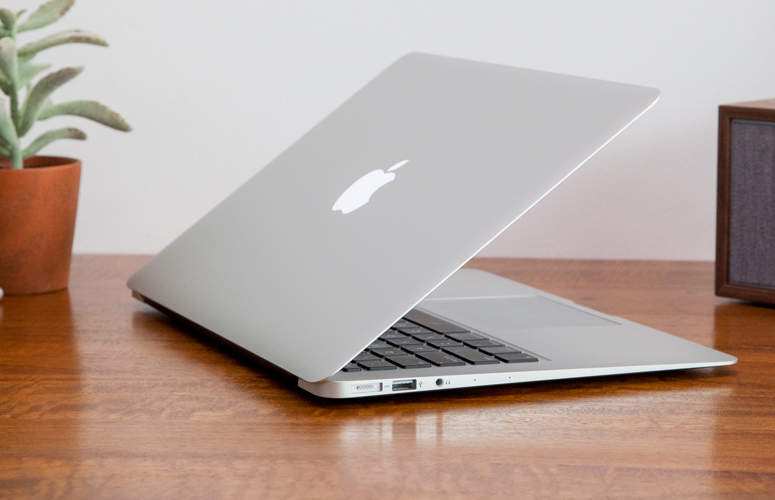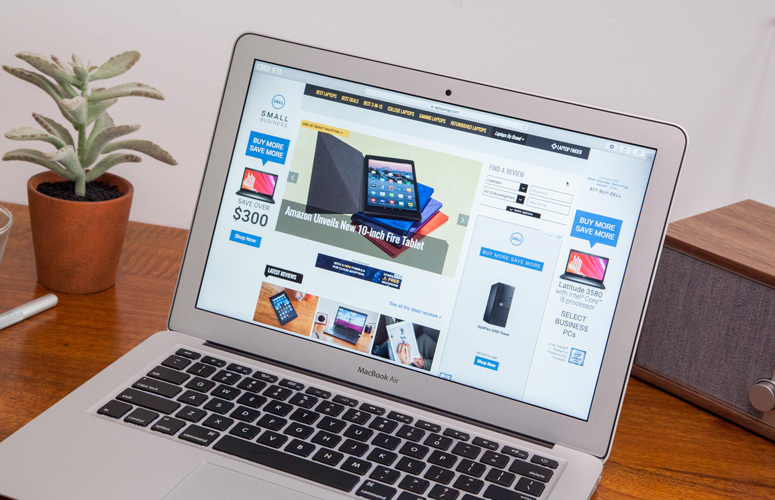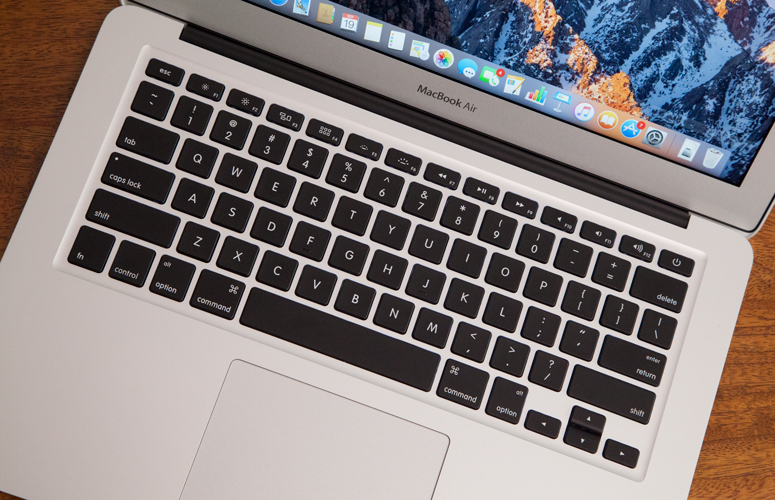Laptop Mag Verdict
The MacBook Air may not be a flagship notebook, but this 13-inch ultraportable is still a pretty good value.
Pros
- +
Long battery life
- +
Comfortable keyboard
- +
Solid performance
- +
Convenient MagSafe power port
Cons
- -
Lackluster display
- -
Heavier than competitors
Why you can trust Laptop Mag
July 9 Update: Apple discontinued this MacBook Air, leaving just the 2018 MacBook Air in its place.
You may not have noticed, but Apple upgraded the MacBook Air in 2017. Specifically, the $999 13-inch notebook got a slightly speedier, 1.8-GHz Core i5 CPU, upgrading from a 1.6-GHz Core i5 processor. While we appreciate that the Air still has the best-feeling keyboard on a Mac and its USB 3.0 ports don't send us shopping for dongles, this machine's low-res display holds it back. However, if you're looking for a relatively affordable Mac laptop, the Air is a solid choice..
MacBook Air 2017 Design
The MacBook Air's unibody aluminum chassis is so iconic that it's tied in my head to the late 2000s and early 2010s. Back then, it was the new kid on the streets, but now, everyone from Acer to LG is making even thinner metallic unibody notebooks.

Weighing 3.0 pounds and measuring 0.7 inches thick, the MacBook Air doesn't measure up well to more modern machines. The Acer Swift 7 (2.5 pounds, 0.4 inches), Asus ZenBook UX330UA (2.7 pounds, 0.5 inches) and 12-inch Apple MacBook (2.0 pounds, 0.5 inches) are all lighter and thinner.
MacBook Air 2017 ports
The Air splits its dual USB 3.0 ports between its sides, with a MagSafe 2 charging connector and headphone jack on the left and an SDXC memory reader and Thunderbolt 2.0 port on the right.

While some will lament the lack of USB Type-C or Thunderbolt 3 ports, I'm perfectly happy living an adapter-free life with those USB 3.0 ports and feeling like my notebook is safer thanks to the MagSafe connector. When you apply tension, this cable detaches more easily and safely than USB Type-C cables, which would pull a device down with it when snagged by a running pet or child.
MORE: Surface Laptop vs MacBook Air: It's Not Even Close
MacBook Air 2017 display
The MacBook's 1440 x 900-pixel screen has aged more poorly than any of its other aspects, lacking full HD and vibrant colors. While the screen managed to emit inky-black tones for a John Wick: Chapter 2 trailer, a wooden chest in the clip appeared more faded than it should have, and a burning house didn't offer proper glow.

Even though Apple doesn't seem to believe the Air needs a Retina-level, or at least full-HD (1920 x 1080 pixels) display, I felt as if my eyes had gotten worse after using this machine for extended periods, as text on the screen doesn't look as sharp as it does on any of my personal devices.
Our colorimeter measured the MacBook Air as producing 71 percent of the sRGB spectrum, which is beneath the 100 percent category average and low for this price. The Swift 7 (105 percent), ZenBook UX330UA (106 percent) and 12-inch MacBook (117 percent) all rated higher.
The Air tries to make up for its color deficiency with brightness, emitting up to 336 nits. That's similar to the 340-nit 12-inch MacBook, and it outshines the 290-nit category average, the 319-nit Swift 7 and the 286-nit ZenBook UX330UA. Unfortunately, this brightness isn't enough to produce solid viewing angles, as I saw color darken at 45 degrees to the left and right.
MacBook Air 2017 keyboard and trackpad
The MacBook Air offers a pleasant typing experience, with keys that actually feel like they're moving -- something I'll never take for granted again. With it, I hit an average of 76 words per minute on the 10fastfingers.com typing test, which isn't too far from my 80-wpm average. That speed, and the comfort I experienced during the test, is enabled by the 1.4 millimeters of travel in the keys, which require 72 grams of force to actuate.

For comparison, I tried out the shallower, clickier keys on the 15-inch MacBook Pro (whose keys have 0.8 mm of travel and require 74 grams of actuation force). While I hit a relatively similar 74 wpm on that machine, my hands started to hurt during the test, which I attribute to how much less travel is in those keys. The 12-inch MacBook's similarly designed keys are even shallower, with 0.5 mm of travel.
The MacBook Air's 4.0 x 2.9-inch trackpad offers accurate tracking and a solid feel to each click. It's also arguably easier to use than those in Apple's 12-inch MacBook and MacBook Pros, as it actually moves. Here, dragging and dropping items -- something you need to relearn on the Force Touch trackpads that appear on more advanced MacBooks -- is a whole lot easier.
MacBook Air 2017 audio
Good sound never gets outdated, and the MacBook Air continues Apple's track record of laptops with sweet-sounding audio, blasting enough volume to fill our medium-size conference room. When listening to Rocky Romero's "RPG Vice" and Survive's "Sorcerer" on the notebook, I noted clear vocals, full bass and accurate synths.
MacBook Air 2017 performance
The MacBook Air's Intel Core i5-5350U CPU and 8GB of RAM enable smooth and speedy multitasking. For example, I saw no slowdown after I split my screen between a 1080p YouTube video and a dozen Safari tabs (including Slack, Google Docs and Giphy).

The MacBook Air notched a respectable score of 6,438 on the Geekbench 4 general performance test. That's close to the 6,565 category average, above the 5,519 from the Swift 7 (Core i5-7Y54, 8GB of RAM), and below the 7,182 from the ZenBook UX330UA (Core i5-7200U, 8GB of RAM) and the 6,853 from the 12-inch MacBook (Core M3-7Y32, 8GB of RAM).
The MacBook Air's 128GB PCIe solid-state drive copied a DVD's worth of files in just 24 seconds, for a rate of 212 MBps. That's similar to the 215-MBps category average and faster than the 116 MBps from the Swift 7 (256GB SSD) and the 159 MBps from the ZenBook UX330UA (256GB SSD). We recorded a much faster 467 MBps from the 12-inch MacBook (256GB SSD).
Macs aren't exactly seen as speedy gaming machines, and the Air doesn't buck that conventional wisdom. The integrated Intel HD Graphics 6000 chip in the Air ran the racing game Dirt 3 (set to medium graphics and 1920 x 1080 pixels) at 25 frames per second. We consider 30 fps playable.
MacBook Air 2017 battery life
Don't worry about lugging your power cable everywhere you go, because the MacBook Air's battery has your back. The MacBook Air lasted 10 hours and 26 minutes on the Laptop Mag Battery Test (web browsing at 100 nits), which is similar to the 10:17 from the ZenBook UX330UA and longer than the 7:25 from the Swift 7 (7:25), the 9:29 recorded by the 12-inch MacBook and the 8:20 category average.
MORE: Longest Battery Life Laptops
MacBook Air 2017 webcam
Integrated webcams often provide the bare minimum of quality and accuracy, but the 0.7-megapixel camera in the MacBook Air exceeded my expectations. It not only nailed the purple hue of my shirt but also accurately captured a tiny stretch detail above the D. Of course, it isn't perfect, as a block of my hair looks like a flat brown patch.
MacBook Air 2017 heat
The MacBook Air still does a good job of dispersing heat. After we streamed HD video on the notebook for 15 minutes, our heat gun captured temperatures on its touchpad (83.5 degrees Fahrenheit), G and H keys (92 degrees) and underside (94 degrees) that didn't breach our 95-degree comfort threshold.
MacBook Air 2017 software
Our MacBook Air came running macOS Sierra, which brought Siri to the Mac, and it took less than an hour for us to install the recently released High Sierra. Unlike most of the PC laptops we review, macOS features zero bloatware.
We've found High Sierra to be an excellent update, making slight, welcome improvements to important apps and keeping macOS just as usable and stable as ever.
MacBook Air 2017 configuration options
We tested the $999 entry-level MacBook Air, which packs an Intel Core i5-5350U processor, 8GB of RAM, a 128GB PCIe SSD and a 1440 x 900-pixel panel.
Doubling your storage (to 256GB) adds on $200 (for a total of $1,199), and moving it up to 512GB adds on $400 (for $1,399). Upgrading to a 2.2-GHz Core i7 CPU costs an extra $150.
Bottom line
The MacBook Air may be going gray (well, silver) as it ages, but we still love its long battery life, solid performance and safety-first MagSafe 2 power port. You also don't have to worry about schlepping any dongles to plug in peripherals. Two downsides, however, are that its display is stuck in the past decade, and it's up to a pound heavier than competitors.

Platform-agnostic users can save $300 with a similarly configured Asus ZenBook UX330UA, which boasts a brighter, more colorful panel. If you're partial to the Apple experience and want to keep the cost reasonable, you've got two options. If you plan to watch a lot of video and are constantly on the move, the 12-inch MacBook, which costs $300 more, will be best. Writers and other keyboard jockeys, though, will get the best experience on the 13-inch MacBook Air.
Apple MacBook Air (13-inch 2017) Specs
| Bluetooth | Bluetooth 4.0 |
| Brand | Apple |
| CPU | 1.8GHz dual-core Intel Core i5 |
| Card Slots | SDXC |
| Company Website | https://www.apple.com/shop/buy-mac/macbook-air |
| Display Size | 13.3 |
| Graphics Card | Intel HD Graphics 6000 |
| Hard Drive Size | 128GB SSD |
| Hard Drive Type | PCIe SSD |
| Highest Available Resolution | 1440 x 900 |
| Native Resolution | 1440x900 |
| Operating System | macOS Sierra |
| Ports (excluding USB) | Headphone, Thunderbolt 2.0, USB 3.0 |
| RAM | 8GB |
| Size | 12.8 x 8.9 x 0.7 inches |
| Touchpad Size | 4.1 x 3 inches |
| USB Ports | 2 |
| Video Memory | Shared |
| Warranty/Support | 90 days of technical support, 1-year limited warranty. |
| Weight | 2.98 pounds |
| Wi-Fi | 802.11ac |
